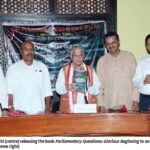“If a second chamber dissents
from the first, it is mischievous;
if it agrees, it is superfluous.”
– Abbé de Sièye, political philosopher
of the French revolution
PARLIAMENT is in a crisis which is not likely to blow over soon. The crisis is formed of several intertwined strands—ideological, personal and institutional. The ideological divide between the Bharatiya Janata Party (BJP) and the rest of the political parties, particularly the Congress, has been there since the very inception of the Rashtriya Swayamsevak Sangh (RSS) in 1925 and that of the Jan Sangh in 1951. There is little chance that it will ever be bridged. Personal hatred between the leaders of the two sides has also been mutual from the very beginning but it seems a lot more visceral today than it ever did in the past. The institutional strand is the one that is going to be the most difficult to straighten out, for it is embedded in the very making of our Westminster-derived bicameral Parliament.

The bicameral structure worked well as long as one party ruled supreme throughout the country—both in the Lok Sabha and the Rajya Sabha at the Centre and in the Vidhan Sabhas and the Vidhan Parishads in the states. But once this single-party supremacy began tottering from 1967 onwards, the structure has been giving way steadily and unceasingly. Many states have abandoned the bicameral structure and have worked well with only the directly elected legislature. The reasons why a bicameral Parliament was considered desirable can be found in the elaborate debates of the Constituent Assembly and the Nehru Committee report on the subject. They were valid reasons when they were given, when the hopes of the nation-builders were soaring high and when their essential trust in the sincerity of purpose of men in public life was yet untried. Many of us may begin to have doubts about those reasons today when our public life has become so severely strident, so unpalatably coarse, self-interested and narrow-minded.
Bicameral legislatures and bipartisan politics are failing in even the most advanced countries even as many new countries are adopting the practice. America has been steadily rolling down a precipice because of the fiercely bipartisan nature of its politics. Every American citizen today seems fed up with the way legislation gets so frequently gridlocked in their Senate and pity the Presidents who look so utterly helpless before the bipartisan divide. Watchers of the national scene are unanimous that America is in economic and social decline because of constant deadlocks killing vital legislation. What makes them even more desperate is that they see no hope of constitutional reform or a change in the stance of national political parties even in the far future.
Italy is another nation that has been nearly paralysed by the equal powers of the two houses of its parliament. Current prime minister Matteo Renzi, who heads a rickety coalition, is trying to restrict the powers of the Senate to pull back the country from the edge of what seems to be sure doom. However, according to an observer, Renzi’s effort to revitalise the country’s democracy “is not looking terribly healthy”. Japan can be cited as yet another country of shaky coalitions that its majority leader is often forced to form because of the incongruent majorities of its two houses called Kokkai and Shugiin.
PROBLEMS created by bicameralism have grown so noticeable that some American educational institutions have even created study courses in the subject. Game theorists are experimenting on mathematical models to test whether equilibrium or stable formations are feasible within a bicameral, bipartisan bargaining framework. The Indian bicameral crisis is prickly, but not obstructive. The Rajya Sabha can hold up legislation but cannot bring the government of the day to a halt because it cannot indefinitely stall Finance Bills as the upper chambers can do in some other countries. And yet, if the deadlock and disruption in the Rajya Sabha continue to hinder reform and enfeeble the administration, people are bound to wonder whether we really need an upper house which only seems to be interested in sticking pins in the behind of the ruling side. Maybe it is time to draw out the relevant copies of the Constituent Assembly debates and test the merit and functioning of today’s Rajya Sabha against the sort of upper house the founding fathers had envisioned.
One can say without being totally wrong that the current crisis is not entirely due to the bicameral structure of Parliament but due mainly to the bristling personality of Narendra Modi. It is, after all, absolutely true that Modi is seen in many quarters as absolutist, arrogant and unbending. It is a different matter that he also sees Sonia Gandhi and her courtiers as a bunch of peevish knaves acting out of pique over losing power to a chaiwalla. Sonia actually may think of him as even worse. In her eyes, Modi is a mere conjurer of the electronic age and a chicaner of the worst sort, who is now wanting the Congress to support the very measures he had stalled when he was in the opposition. These Congressmen say that what was witnessed in Parliament during the last monsoon session was not a bicameral crisis but a ‘personality crisis’. After all, Parliament did function reasonably calmly in similar circumstances when Atal Bihari Vajpayee of the BJP was the Prime Minister. But Vajpayee was able to contrive a working arrangement with the Congress in Parliament because he had known and dealt across parliamentary benches for many years. It makes a difference when you have friends and admirers even among your enemies, which Modi does not have.




























































